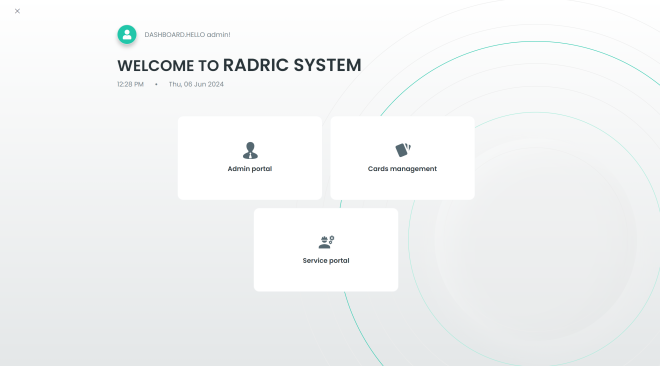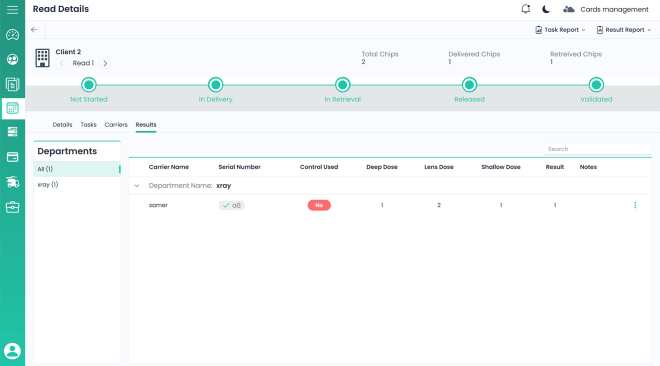Radiation Safety System – From 40 to 4 days
Summary
Ensuring the safety of personnel working with radiation is critical across various industries, especially in healthcare. In Saudi Arabia, hospitals, dental clinics, and medical labs pose potential health risks from radiation exposure for staff.
Our client, a leading radiation safety business in the region, specializes in mitigating these risks. They utilize a robust Quality Control (QC) program and perform quarterly monitoring via OSL chips (dosimeter cards) worn by personnel.
This contractual service model ensures close monitoring of radiation levels and safeguards the health of healthcare workers.


Problems
1- Chips Chaos:
Manual Chip Assignment:
Spreadsheets and paper records made it difficult to efficiently assign OSL chips to specific staff members and medical centers. This could lead to:
. Incorrect Assignments:
Staff members might not receive the correct chip type or the required number of chips.
. Duplication:
Duplicate assignments could result in wasted resources and confusion.
Employee Changes:
Staff turnover and changes in schedules created challenges in updating chip assignments and ensuring proper handover of monitoring responsibilities. This could lead to:
. Unassigned Chips:
Vacant positions might leave assigned chips unaccounted for, creating security concerns and potential data gaps.
. Incomplete Data:
Inconsistent tracking of chip usage by departing staff could lead to incomplete data sets for radiation exposure analysis.
Inefficient Delivery Process:
Coordinating chip deliveries with medical centers relied heavily on manual communication and scheduling. This could cause:
. Missed Deliveries:
Delays in receiving new chips could disrupt monitoring schedules and potentially expose personnel to radiation risks.
. Lost/Delayed Chips:
Inefficient tracking systems could lead to lost or misplaced chips, requiring replacements and additional costs.
Limited Card Tracking:
Manual record-keeping made it difficult to track the location and status of deployed OSL chips. This resulted in:
. Retrieval Issues:
Difficulty retrieving used chips for analysis could cause delays in generating radiation exposure reports.
. Expired Chips:
Staff members might inadvertently continue using expired chips, compromising the accuracy of radiation exposure data.
2- Lack of Analytics (Active Contracts, Remaining Quarters):
Manual Contract Management:
Paper-based contracts and spreadsheets made it difficult to track contract details, renewal dates, and active service agreements. This resulted in:
. Missed Renewals:
Delays in renewing contracts could lead to service disruptions and potential safety gaps.
. Revenue Leakage:
Inaccurate contract tracking could make it difficult to accurately forecast revenue and identify missed billing opportunities.
Limited Data Visibility:
Lack of centralized data storage made it challenging to access vital information about remaining service quarters for each client. This could lead to:
. Unforeseen Service Gaps:
Running out of allocated monitoring periods could force unplanned service interruptions.
. Inefficient Resource Allocation:
Difficulty in identifying expiring service contracts could lead to reactive rather than proactive resource allocation for client needs.
3- Limited Reporting Capabilities:
The legacy system lacked the flexibility to generate customizable reports needed by both sales and accounting teams. This resulted in:
. Sales Blind Spots:
Sales teams struggled to track key metrics like signed contracts for OSL deployments and QC services. This hindered their ability to accurately forecast revenue and close deals efficiently.
. Financial Uncertainty:
Accounting faced difficulties in reconciling sales figures with actual deployments due to a lack of comprehensive reports. This led to inaccurate financial forecasting and potential revenue leakage.
4- Manual Processes and Errors:
The system’s reliance on manual data entry significantly increased the risk of errors in contract processing and billing. This caused:
. Delayed Service Delivery:
Errors in contract processing led to delays in setting up critical monitoring services for clients, impacting their safety schedules.
. Accounting Headaches:
Discrepancies between sales figures and actual deployments created cumbersome reconciliation tasks for the accounting team. This wasted valuable time and resources.
5- Inefficient Quality Control (QC):
The QC team faced significant challenges due to:
. Manual Scheduling:
Scheduling equipment maintenance and calibrations manually was inefficient and prone to human error, potentially impacting the accuracy of radiation measurements.
. Data Silos:
Information about deployed equipment and QC results resided in isolated systems, hindering data analysis and informed decision-making.
. Limited Reporting:
The legacy system lacked the ability to generate comprehensive QC reports. This made it difficult to track trends, identify potential safety issues, and provide clear reports to clients.
. Communication Gaps:
Inconsistent communication between QC, sales, and client teams led to confusion and misinterpretations of QC results. This could have jeopardized the effectiveness of radiation safety measures.
6- Communication Gaps:
Inaccurate and inefficient communication between the Cards Manager, Delivery Engineers, and Medical Centers created significant issues:
. Delivery Delays and Inconsistencies:
Confusion regarding card delivery timing and quantities led to delays in deploying new chips and retrieving used ones. This disrupted monitoring schedules and potentially exposed staff to radiation risks.
. Misplaced Cards & Safety Gaps:
The lack of a centralized tracking system for deployed OSL chips increased the risk of misplaced cards. This could compromise data integrity and potentially leave staff members unmonitored.
Solution
. ERPNext Implementation:
ERPNext is an enterprise resource planning (ERP) tool designed to provide businesses with the automation and support they need for their operations We implemented a cloud ERPNext , providing a centralized platform to manage the entire sales cycle. This streamlines order processing, contract management, and customer relationship management, ensuring transparency and efficiency.
. Custom Radiation Safety Software:
We developed a custom software solution to manage the company operation. The software designed to suit their business model and specific needs, and at the same time seamlessly integrated with the ERPNext system. The software contains multiple portals to manage the roles efficiently. That includes Admin Portal, Chips Management, QC Management, Service Portal and Client Portal. Each one provide the needed information and operation to manage all the aspects of the business efficiently and effectively.
. Admin portal: Where the administration of the system takes place. That includes the management of the system and ERP Integration, general system settings, configurations, users and permissions, clients and contracts management and many more.
. Chips Management: This portal is for the chip management managers to streamline the process of delivering and retrieving chips, to and from clients. From this portal the manager can manage clients chips contracts, create delivery and retrieval tasks and assign it to engineers, monitor the progress of the tasks and read the OSL results and report back to administration.
. QC Management: Here the QC managers can create and track the PPM tasks related to the operation of Quality Assurance & Control of radiation facilities and devices at clients locations.
. Service portal: Engineers can handle their tasks from this portal, including chips tasks and QC tasks. In chips tasks, the engineer collect the chips from the chips management manager and deliver it to the clients, And retrieve the chips back to the management and every possible case in between such as lost or damaged chips.
. Client Portal: Where the clients can login to their accounts to manage their profile and have an overview of the state of their contracts, the progress of the operations and get some reports about the chips OSL results
Result
. Increased Efficiency: Streamlined workflows across sales, chip deployment, and QC directly translate to faster service delivery for clients. This ensures timely deployment of monitoring services and eliminates delays that could disrupt their safety schedules. Additionally, saved time and resources can be reallocated to client support and proactive safety initiatives.
. Improved Data Accuracy: Automated processes and real-time data visibility minimize errors and ensure data integrity. This translates to reliable and accurate reporting for clients, enabling them to make informed decisions about their radiation safety needs. Furthermore, accurate data empowers the business to optimize service offerings based on client requirements.
. Enhanced Safety: Improved chip tracking and efficient retrieval procedures directly promote a safer working environment for personnel. This aligns with the core value of client safety, a cornerstone of a customer-centric approach. Additionally, the software helps identify potential safety issues through improved data analysis, allowing for proactive measures to safeguard staff.
. Better Customer Service: Faster turnaround times, accurate communication, and efficient chip retrieval enhance client satisfaction. This aligns perfectly with a customer-centric orientation that prioritizes client experience. Improved communication fosters trust and transparency, while efficient processes ensure clients receive uninterrupted and reliable radiation safety services.
. Informed Decision Making: Consolidated data from sales, deployments, and QC empowers informed choices regarding service offerings and resource allocation. This allows the business to tailor services to meet specific client needs while strategically allocating resources to ensure optimal support. Ultimately, this data-driven approach fosters continuous improvement in client services and safety measures.



contact us
Let’s work together!







